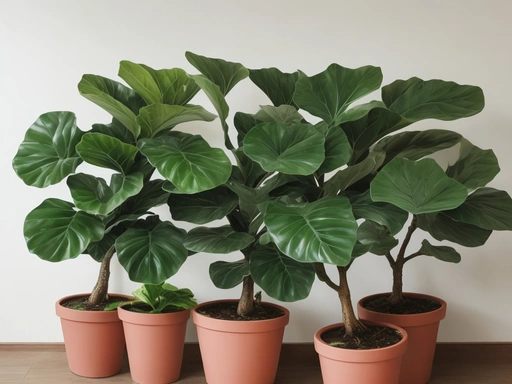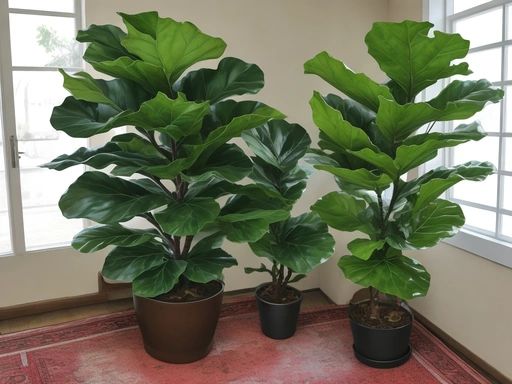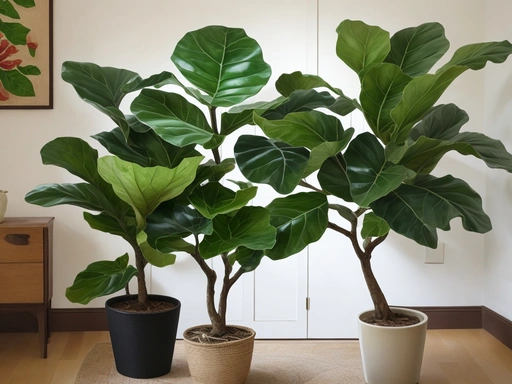Fiddle-Leaf Fig Vs. Other Indoor Plants Comparison: The Ultimate Guide
Key Takeaways:
- Fiddle-leaf figs are ideal for bright, indirect light, while other indoor plants have more flexible lighting requirements.
- Fiddle-leaf figs require more maintenance and care compared to other indoor plants.
- Fiddle-leaf figs can be more challenging to propagate than other indoor plants.
- Fiddle-leaf figs have large, eye-catching leaves that can make a bold statement in any indoor space.
Are you looking to add some greenery to your indoor space but can’t decide which plant to choose?
Well, look no further because today I’m going to delve into the world of indoor plants and compare the popular fiddle-leaf fig with some of its contemporaries.
From the low-maintenance snake plant to the vibrant pothos, we’ll explore the characteristics, benefits, and care tips for each of these plants.
Whether you’re a beginner or an experienced plant parent, this comparison will help you make an informed decision.
So, let’s get started and find the perfect green companion for your home!
| Fiddle-leaf fig | Other indoor plants | |
|---|---|---|
| Light requirements | Bright, indirect light | Varies depending on the plant |
| Watering needs | Regular watering, allowing soil to partially dry out between waterings | Varies depending on the plant; some need more frequent watering, while others prefer drier conditions |
| Size | Tall and bushy, can reach up to 10 feet (3 meters) | Varies depending on the plant; can range from small tabletop plants to taller, floor-standing varieties |
| Care level | Moderate | Varies depending on the plant; some are easy to care for, while others require more attention |
| Decorative appeal | Large, glossy leaves add a touch of elegance to any room | Varies depending on the plant; different shapes, colors, and textures can enhance the decor |
| Air-purifying abilities | Excellent at removing certain toxins from the air | Varies depending on the plant; some indoor plants have air-purifying properties |
Fiddle-leaf fig: An overview
The fiddle-leaf fig, known for its large, glossy leaves, is a popular indoor plant choice.
Characteristics of a fiddle-leaf fig
The fiddle-leaf fig is a popular indoor plant known for its large, glossy leaves. It can grow up to 6 feet tall and has a unique violin-shaped leaf, which gives it its name.
Fiddle-leaf figs require bright, indirect light and prefer a consistent temperature.
They are moderately drought-tolerant and should be watered when the top inch of soil feels dry. With the right care, a fiddle-leaf fig can be a beautiful and eye-catching addition to any home.
Benefits of having a fiddle-leaf fig at home
Having a fiddle-leaf fig at home can bring several benefits.
Not only do they add a touch of greenery and beauty to your space, but they also help to purify the air by removing toxins.
Fiddle-leaf figs are relatively low-maintenance plants that can thrive indoors, making them a great choice for plant enthusiasts of all experience levels.
Additionally, their large, vibrant leaves can create a sense of calm and tranquility in your home.

Care tips for fiddle-leaf figs
To take care of your fiddle-leaf fig, place it in bright, indirect light and avoid direct sunlight. Water it when the top inch of soil feels dry, and make sure the pot has good drainage.
Maintain humidity by misting the leaves occasionally or placing a humidifier nearby.
Dust the leaves regularly to keep them clean. And finally, be patient with your fiddle-leaf fig’s growth – it may take time for new leaves to emerge!

Comparison with other indoor plants
Other indoor plants, such as the snake plant, pothos, rubber plant, peace lily, and ZZ plant, offer different characteristics and benefits compared to the fiddle-leaf fig.
Snake plant vs. fiddle-leaf fig
The snake plant and fiddle-leaf fig are both popular indoor plants, but they have some key differences. The snake plant is low-maintenance, tolerates low light, and has air-purifying properties.
The fiddle-leaf fig requires more care, needs bright indirect light, and has a larger size.
It ultimately depends on your personal preferences and the conditions in your home.
Pothos vs. fiddle-leaf fig
Pothos and fiddle-leaf figs are both popular indoor plants, but they have some key differences.
Pothos has trailing vines with heart-shaped leaves and is known for being easy to care for.
Fiddle-leaf figs have large, glossy, violin-shaped leaves and require more attention.
Both plants can thrive in low to bright indirect light.
Pothos is more forgiving when it comes to watering, while fiddle-leaf figs are pickier and need to be watered less frequently.
In terms of size, fiddle-leaf figs can grow much taller and require more space.
So, if you want a low-maintenance plant, go for pothos, but if you’re up for a challenge and want a stunning focal point in your space, choose a fiddle-leaf fig.
Rubber plant vs. fiddle-leaf fig
The rubber plant and the fiddle-leaf fig are both popular choices for indoor plants. The rubber plant has shiny, dark green leaves that can grow quite large.
It is relatively easy to care for and can tolerate low-light conditions.
On the other hand, the fiddle-leaf fig has large, violin-shaped leaves that are known for their elegance. It requires bright, indirect light to thrive.
In terms of maintenance, the rubber plant is more forgiving and can handle occasional neglect.
The fiddle-leaf fig, however, needs regular attention to watering and humidity levels. Ultimately, the choice between the two depends on your preference for leaf shape and the amount of natural light available in your space.
Peace lily vs. fiddle-leaf fig
Peace lilies and fiddle-leaf figs are both popular indoor plants, but they have some key differences.
Peace lilies are known for their white flowers and ability to purify the air, while fiddle-leaf figs have large, glossy leaves and make a striking focal point in any room.
Peace lilies are generally easier to care for, requiring less light and water, while fiddle-leaf figs need bright, indirect light and more consistent watering.
Ultimately, the choice depends on your preference and the conditions in your home.
ZZ plant vs. fiddle-leaf fig
ZZ plants are known for their resilience and ability to tolerate low light conditions. They have glossy, dark green leaves that grow in an upright manner.
Fiddle-leaf figs, on the other hand, have large, waxy leaves with a distinct violin-like shape.
They require bright, indirect light to thrive. While ZZ plants are low maintenance and can go longer periods without water, fiddle-leaf figs require more consistent watering.
In terms of aesthetic appeal, fiddle-leaf figs are popular for their elegant and statement-making presence, while ZZ plants have a more understated and versatile look.
Factors to consider when choosing an indoor plant
When choosing an indoor plant, consider factors such as light requirements, watering needs, maintenance and care level, size and growth rate, and aesthetic appeal.
Light requirements
Fiddle-leaf figs need bright, indirect light to thrive. They prefer a well-lit spot near a window where they can receive a few hours of direct sunlight each day.
Avoid placing them in low-light areas as this can lead to stunted growth and leaf drop.
Watering needs
Fiddle-leaf figs have moderate watering needs. Water them when the top inch of soil feels dry to the touch.
Make sure not to overwater them, as this can lead to root rot.
It’s best to water deeply and allow the excess water to drain out. Avoid letting the plant sit in standing water.

Maintenance and care level
Taking care of a fiddle-leaf fig requires some effort, but it’s manageable.
The maintenance level can be moderate to high.
You need to ensure it gets enough sunlight, water it regularly but not excessively, and keep an eye out for pests.
Regular pruning and dusting the leaves can also help to keep it healthy.
It’s important to follow these care tips to ensure your fiddle-leaf fig thrives.

Size and growth rate
Fiddle-leaf figs can grow quite tall, reaching heights of up to 6 feet or more.
They have a moderate growth rate, typically growing around 1-2 feet per year.
However, it’s important to note that the growth rate may vary depending on factors like light, water, and overall care.
Aesthetic appeal
The fiddle-leaf fig is known for its stunning aesthetic appeal. With its large, glossy leaves and tall, upright stature, it adds a touch of elegance and sophistication to any indoor space.
The lush green foliage creates a vibrant and refreshing atmosphere, making it a popular choice for interior designers and plant enthusiasts alike.
Whether placed in a minimalist modern setting or a cozy bohemian corner, the fiddle-leaf fig’s beauty is sure to enhance the overall decor of your home.
Frequently Asked Questions
How often should I water a fiddle-leaf fig?
Water your fiddle-leaf fig when the top inch of soil feels dry to the touch. Stick your finger into the soil and if it feels moist, wait a bit longer.
Overwatering can lead to root rot, so it’s better to underwater than overwater.
Aim for every 1-2 weeks, adjusting based on humidity and season.
Can I place a fiddle-leaf fig in a low-light area?
Yes, you can place a fiddle-leaf fig in a low-light area, but it may not thrive as well as it would in bright, indirect light. Fiddle-leaf figs prefer bright, filtered light, so if your low-light area doesn’t receive any natural light at all, it may struggle to grow and may even lose its leaves.
However, if the area receives some indirect light or you can supplement with artificial light, it may still survive, albeit with slower growth and less lush foliage.
Just make sure to monitor the moisture levels and adjust your watering accordingly, as the lower light levels will affect the plant’s water requirements.
How do I propagate a fiddle-leaf fig?
To propagate a fiddle-leaf fig, you can follow these steps:
- Choose a healthy stem: Look for a stem with multiple leaves and no signs of damage or disease.
- Prepare a cutting: Using clean, sharp shears, cut a section of the stem that is about 6-8 inches long. Make the cut just below a set of leaves.
- Remove lower leaves: Strip off the lower leaves, leaving only a few at the top.
- Optional: Apply rooting hormone: This can help stimulate root growth, but it’s not necessary.
- Place in water or soil: You have two options for propagation. You can either place the cutting in a glass of water, making sure the bottom nodes are submerged, or directly plant it in a small pot with well-draining soil.
- Provide the right conditions: Keep the cutting in a warm and bright location, away from direct sunlight. Make sure to keep the soil moist (not soggy or the water in the glass topped up.
- Wait and monitor: Roots should start to develop within a few weeks. Once the roots are around 1-2 inches long, you can transplant the cutting into a larger pot with regular potting soil.
Propagation can be a fun and rewarding process, so give it a try and enjoy watching your fiddle-leaf fig grow!
What are the common pests and diseases that affect fiddle-leaf figs?
The common pests and diseases that affect fiddle-leaf figs include:
- Spider mites: These tiny pests can cause yellowing leaves and webbing on the plant.
- Mealybugs: They appear as white, fuzzy pests and can cause leaf discoloration and stunted growth.
- Scale insects: They look like small, brown bumps and can weaken the plant by feeding on its sap.
- Root rot: Overwatering can lead to fungal infections and root rot, causing the plant’s leaves to droop and turn brown.
- Leaf spot: This fungal disease causes dark spots on the leaves, which can spread if not treated promptly.
To keep your fiddle-leaf fig healthy, regularly inspect for pests, avoid overwatering, and provide adequate light and humidity. If you notice any issues, take immediate action to prevent further damage.
Which indoor plant is best for beginners?
A snake plant is a great choice for beginners.
It’s durable, low-maintenance, and can tolerate a range of light conditions.
Pothos and ZZ plants are also beginner-friendly options.
These plants are forgiving if you forget to water them occasionally and they can thrive in low light environments.
Final Verdict
The fiddle-leaf fig is a popular choice for indoor plant enthusiasts due to its unique characteristics and benefits.
Its large, glossy leaves and tall stature make it a statement piece in any room.
While it does require some care and maintenance, following a few simple tips can ensure its health and longevity.
When comparing it to other indoor plants, it stands out for its size, aesthetic appeal, and the ability to thrive in a variety of lighting conditions.
Overall, the fiddle-leaf fig is a great option for those seeking a stunning and versatile indoor plant.






